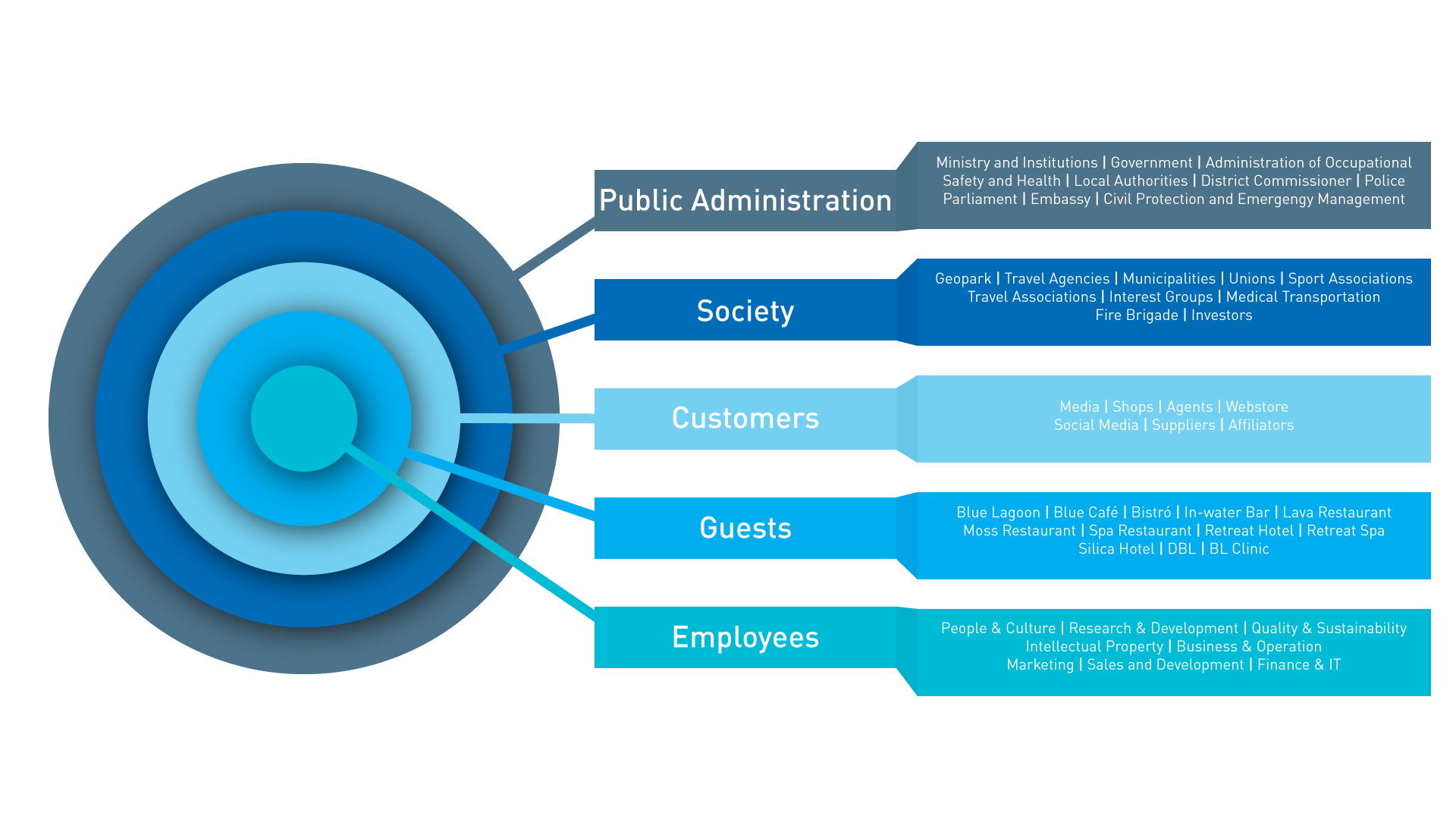Corporate Social Responsibility
“We apply professional work practices and promote good communication with all the company’s stakeholders.”
Since its establishment, Blue Lagoon has emphasized social responsibility, and the Blue Lagoon’s approach to this commitment has developed in line with the development of the company and society. The social responsibility of Blue Lagoon is extensive and includes a responsibility towards nature, society, and sustainability.
This CSR report describes the economic, environmental, and social impact of the company’s operations in 2019 in accordance with the Global Reporting Initiative (GRI) standards. This is the first time the Blue Lagoon Annual Report has included a CSR report with information based on the priorities of the Blue Lagoon and its stakeholders. The aim for 2020 is to re-evaluate these priorities, involve more stakeholders, insert additional performance indicators, and integrate the reporting with the United Nations Sustainable Development Goals (SDG) in the next CSR report.
Covid-19
The whole world, including Iceland, had to respond to the COVID-19 pandemic. Due to the current circumstances and restrictions, Blue Lagoon Iceland had to take extensive measures to adapt its business to a completely new operating environment. Blue Lagoon also had to close all its business units for almost three months, from March 23 to June 19, 2020.
Operational measures in the coming months will aim to protect the company from further disruptions and the great uncertainty that currently prevails in the Icelandic economy. The company’s strong performance in 2019 allows the company to cope with the current circumstances, the reduction in tourism, and future uncertainty surrounding this pandemic.
Blue Lagoon CSR Pillars

The focus of Blue Lagoon Iceland is to create an environment where everyone—both guests and staff— can enjoy themselves safely. Nature is not an endless resource, so environmental sustainability is an important part of the company’s operations as is working in harmony with the community. The company aims to be a role model for sustainability in the tourism industry and to offer social support.
In 2019, a CSR technical interdisciplinary committee was established within the company with the aim to implement corporate social responsibility throughout business operations and improve the company’s performance in social and environmental issues.
Blue Lagoon Stakeholders

In 2019, the Blue Lagoon engaged its employees to improve company processes and gathered feedback from guests to create an even better experience. As a result, over 300 improvements were identified and many of them were immediately implemented. The employee experience was mapped with interviews, follow-ups, and observations. As a result of the research, nine improvement reports were yielded to support decisions and create a better work environment.
The guest experience process was mapped through interviews, surveys, and information boards that resulted in many opportunities to improve our guest service and Blue Lagoon experience.

Goals 2020
We are always aiming for continuous improvement in our operations and will continue to do so in 2020.
In 2020, the aim is to:
- Increase communication with the company’s main stakeholders.
- Further align the Blue Lagoon’s business plans with the United Nations Sustainable Development Goals (SDGs).
- Engage in several environmental and social improvement projects to enrich and improve operations and community relations.
Focus on Environmental Sustainability
The environmental goals for 2020 are based on the Blue Lagoon environmental policy and sustainability plan. Special emphasis is placed on increasing operational sustainability and reducing the company’s environmental footprint, specifically concerning greenhouse gas emissions and waste.
To reduce greenhouse gas emissions, we aim to better control the use of towels in the spas, add car charging stations, and offer plug-in hybrid company cars. To better evaluate the extent of carbon offsetting, we will calculate emissions generated by transportation, consumption of guests’ meals, and production of skin care products at Bláa Lónið Heilsuvörur ehf. (BLH), from start to finish.
To improve the company’s waste management, we aim to:
- Reduce paper printing by improving digital solutions such as the use of Microsoft Teams and SharePoint document management.
- Improve sustainable procurement.
- Begin a life cycle assessment (LCA) of Blue Lagoon geothermal seawater and BLH Skin Care products.
- Increase the sorting of plastic and send for recycling to PureNorth in Iceland.
- Reduce the use of disposable plastic in the customer experience.
- Reduce the amount of packaging in freight and use cardboard packaging rather than plastic.
- Increase multi-use packaging instead of disposable packaging in operations.
These projects will be followed up throughout the year and the results will be evaluated based on the following environmental goals in 2020:



Focus on Heath and Safety
It can be said that the first months of 2020 were characterized by unprecedented conditions and challenges in security and health. Earthquakes, possible magma accumulation in Svartsengi, and winter storms were the main issues for Blue Lagoon at the beginning of the year, until the COVID-19 pandemic took over. In light of these circumstances, the primary emphasis in safety and health has been on reviewing and coordinating the company’s response plans and actions with other responsible parties in the community. Blue Lagoon will continue to place an emphasis on supporting the welfare and ensuring the safety of its staff and guests.
Focus on Human Resources
An emphasis will be placed on building human resources following the restructuring of the company that took place in 2020. Due to the COVID-19 pandemic, Blue Lagoon had to take unavoidable actions and lay off employees, but the company can hopefully hire these people back. There is also a great challenge ahead to maintain the company’s good workplace culture by engaging employees and meeting their needs. To monitor this situation, several and frequent workplace analyzes will be carried out to improve employees’ satisfaction and happiness.
The following indicators will be monitored throughout the year to assess the success of improvements on human resources:




